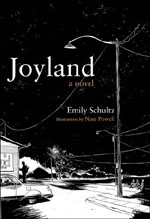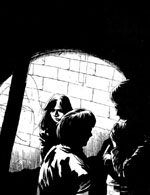TDR
Interview: Emily Schultz
Toronto’s Emily Schultz
discusses books as lovers, joysticks, the difficulties of making car
payments as a writer and her original new novel, Joyland
(ECW, 2006), with fellow writer Ibi Kaslik.
June 2006
*
 IK:
Why did you choose to root Joyland
in the 1980s? IK:
Why did you choose to root Joyland
in the 1980s?
ES: The
story had to be set in the early to mid-80s if I wanted to write about
classic video games, and I desperately did. I suppose I could have set
it in the late ‘70s during the rise of arcade games, but because games
–at that time –were marketed at children, I felt it also had to be a
coming-of-age tale, which led to the idea of the Joyland protagonists
trying hard to hang on to childhood, to innocence. In order to achieve
this ‘hanging-on-to-something-dying-feeling,’ I also had to catch
the moment when video games were on their way out. So I chose 1983, when
Atari stocks crashed hard and home computers grew in popularity,
The novel, I think, is about language
and ways of knowing. Every family knows its members based on a shared
past and the ability to intimately read one another’s inflections,
expressions, and body language. Computers also have their own intimate
language, and when one becomes really good at video games, one is moving
instinctually as well. One’s body knows what is coming next.
IK: So, the characters in Joyland
relate to their changing world through instincts and video games. Beyond
a mode of communication, why did you choose this type of early
technology/form of escapism as the central metaphor in the novel?
ES: I
thought I could stand to spend three or four years shacking up with
video games as a subject. I wasn’t wrong about that. I still like
spending time with Galaga.
IK:
What has changed for you the most as a writer since the release of Black
Coffee Night a few years ago?
ES: Even
though the writing in Black Coffee Night is younger, the book
itself was like an older, sophisticated lover who brought me out and
introduced me to people I would never have met otherwise. And I loved Black
Coffee Night with my whole heart, at the time. Before that, I was a
writer but no one else knew me as one. My relationship with Joyland
is more complicated, the way that second, third, or hundredth
relationship always is. I’ve fallen in and out of love with Joyland
a few times already and we’ve had some really nasty fights. Sometimes
we sit on opposite sides of the room from one another and don’t even
talk.
IK: In
Joyland you contrast adolescent experiences by juxtaposing
violence and tenderness, isolation and community, and, most obviously,
by having both a young male and female point of view. Can you talk about
how and why these juxtapositions function, on the whole, structurally,
stylistically, in your work?
ES: My characters, a brother and
sister, Chris and Tammy Lane, naturally set up those dynamics by virtue
of their ages. At 11, Tammy’s world is more interior; Chris’s, at
14, is exterior. Hers is still tender, naïve, and slow. His is one of
distrust, young cynicism, and speed. Staying within the video game
dynamics, her world is in the home (Atari) and his is at the arcade (Joyland).
The two voices take turns, as Player One and Player Two, telling what
feels, at first, like separate stories, but the two voices eventually
merge into one narrative.
IK:
Can you tell me about the challenges of working and living as a writer
in this great city of ours.
ES: I’ve
lived in Toronto for eight years now. Before that I lived in smaller
cities in both Canada and the U.S. and called them home. Challenges in
Toronto: eating well cheaply, keeping a car, making rent. I work more as
an editor than as a writer.
IK: In Joyland, each chapter
is named after a classic Midway video game (Joust, Donkey Kong, Dig Dug,
etc.) So, why isn't there a chapter titled "Robotron"?
There are lots of games I would have
liked to have covered, but I went with more accessible games so that
non-gamers or people of different generations would feel like they could
come into the play too. Everyone has heard of Pac-Man: case in point, my
grandma used to have a Ms. Pac-Man coffee mug!
When I surveyed acquaintances about
their early game favourites, Robotron came up, and so did others:
Tetris, Gorf, Breakout, Dragon’s Lair. But the real winners were
Donkey Kong, Frogger, Centipede, Space Invaders, Galaxian.
Robotron is a bit like Berzerk as far
as game types go. I chose Berzerk as a chapter partly because it’s
such a great name and also because it’s at that point in the novel
where everything has gone Berzerk and the characters feel things have
slipped out of their control. I also chose games based on the amount of
symbolism I felt could be read/written into their concepts or visual
elements. Donkey Kong Jr. has an obstacle course containing vines,
traps, springboards, chains, birds, keys. I had to find out how many of
those items I could fit into a chapter.
Robotron has a ‘rescuing humans,’
plot which I really like, but that also appears in Defender. I went with
a Defender chapter because I love the concept of seeing both the past
and future; Defender has the radar screen where the player can see both.
Tammy and Chris also believe that they can see the future. Tammy
believes she has ESP; Chris’s heightened senses from years of video
game playing allow him to move instinctually through the world as if it
were an electronic map.
 IK:
Can you tell me about the
artist who did the wonderful sketches for your novel? IK:
Can you tell me about the
artist who did the wonderful sketches for your novel?
ES: Sure. Nate Powell is an
American artist with three graphic novels published by Soft Skull Press.
I found his work through my job at Broken Pencil magazine and was
blown away. After my book was slated for publication, I proposed the
idea of illustrations and my editor really liked it. We thought it would
complement the type of book it is.
Nate’s work is very dark, full of
emotional weight. I emailed Nate and he agreed to do it. He had some
stipulations: he didn’t want to do too much that was ‘80s-specific
and he didn¹t want to show full faces; he thought those should be left
to imagination. I said sure, and he did his own interpretations. He did
paint a video game cabinet, but he obscures its
name. Ditto for the mural of the
Rolling Stones logo that appears on the arcade wall. Instead, Nate
emphasized the novel’s relationship to place; he telescoped in on
generic objects–a swimming pool, a bed, the kids’ father’s suit
–things that are the whole world when you are young. My hat is off to
Mr. Powell.
Ibi Kaslik is the
author of Skinny (www.ibikaslik.net) |
